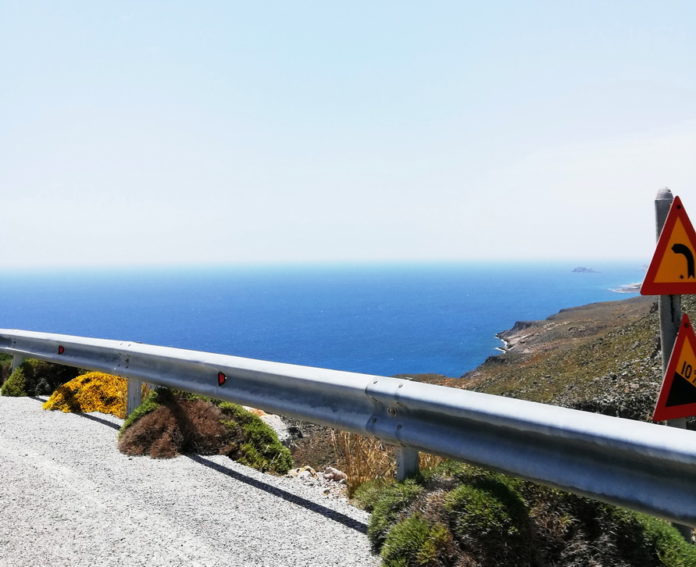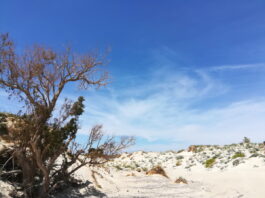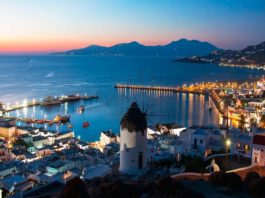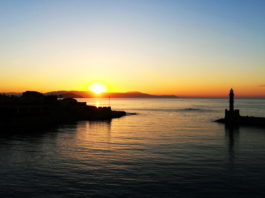Driving in Crete is not only the most practical way to get around this huge island- it’s a pleasure in itself. Crete is Greece’s largest island, with a stunningly diverse landscape that is a joy to drive through. There are towering gorges, dramatic mountains and plateaus, fertile plains, and endless kilometers of coastline with rocky shores and white sandy beaches.
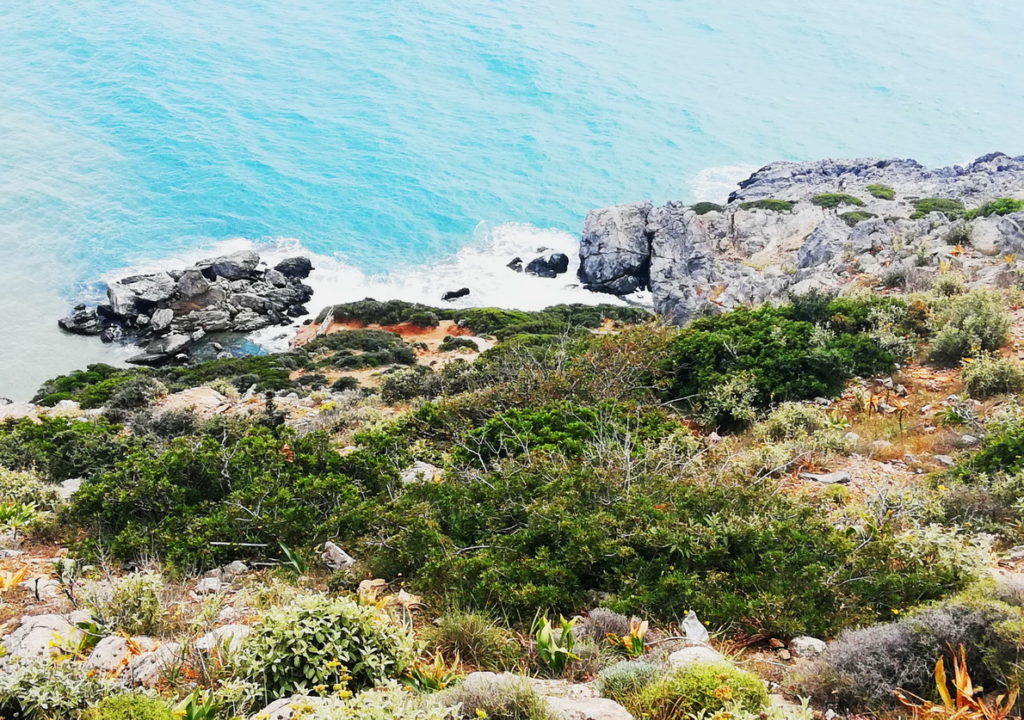
Crete’s four main cities – Chania, Rethymnon, Heraklion, and Agios Nikolaos – are all on the north coast. The north coast of Crete is where the ferries and flights arrive. You’ll find plenty to do here, and also plenty of natural splendor.
But to truly experience the wild and majestic beauty of Crete, you need to drive through its mountains and gorges as well as alongside endless beaches. Your reward for crossing the island to the south coast on the Libyan sea or to the farthest eastern and western ends of the island will be more beaches – but even better ones – less visited and more pristine.
Along the way, you will pass near beautiful gorges – some short enough for an impromptu hike before you continue on the road. You’ll also drive through historic rustic villages, not frequented by tourists. Old style classic “cafenia” shaded by lush plane trees in the town square, churches centuries old, bakeries with wood burning ovens. This is a experience of authentic Crete that you can only enjoy by car.
Table of Contents
An Essential for Driving in Crete – Quality Cars in Good Condition
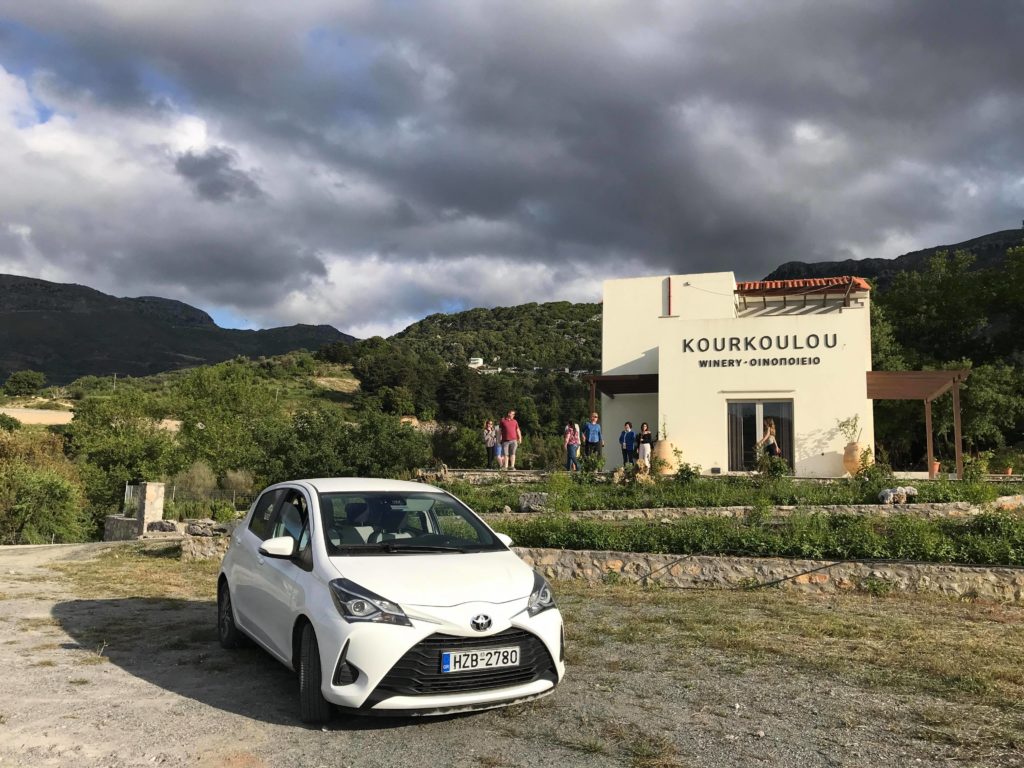
On a recent Travel Bloggers Greece trip, we shared the whole of Crete with our international friends. Rental Center Crete met us at the port of Souda Bay when we docked at sunrise, with two cars in top condition. Roads are generally good in Crete, but for the sharp curves, steep inclines, and narrow passages that you find driving in Crete, you need good brakes and good tires. A reliable rental center is the clear option.
Driving in Crete, Route 1: Chania to Chora Sfakion – 73 km, 1.5 – 2 hours drive
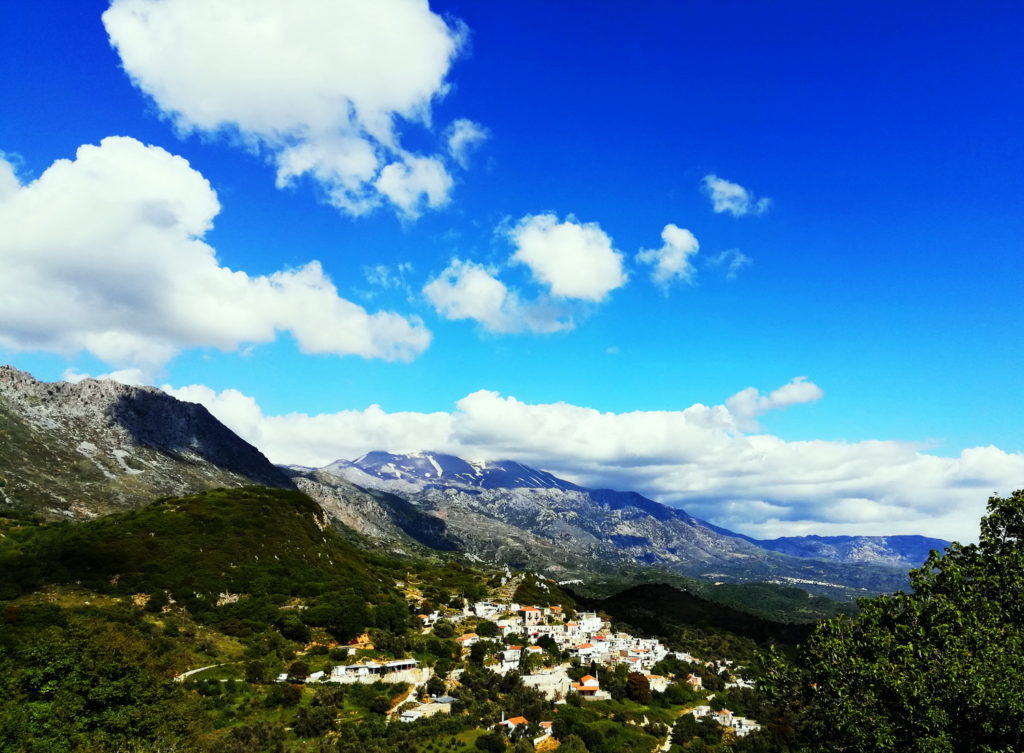
This is one of the most famous routes for driving in Crete. Chania is one of Crete’s most popular destinations with a richly diverse landscape. The route starts out on the main national road VOAK/E75/EO90 that links Chania to Rethymnon and beyond, following the north coast. You’ll pass though some of the loveliest Cretan villages, starting with the inland village of Mournies, birthplace of the great statesman Eleftherios Venizelos. Back at the coast, you’ll see the beachside village of Aptera and Kalyves before veering inland one again towards Vrysses, still on the national road.
Vrysses means fountains or springs; this is a green and shady village that makes a refreshing and scenic stop for a thick Greek coffee or a local soft drink (Cretan lemon soda and orange soda are all natural, tangy with local juices). This is the midpoint of the route. At Vrysses, you’ll turn off the national road and onto the rural route (“EO” or Epar. Od.”) “Vryson – Chora Sfakion,” heading south.
Driving in Crete- Though the White Mountains
The road brings us through the Askifou plateau. At an elevation of 730 meters, the plateau is surrounded by the “Lefka Ori” – White Mountains. This is the Sfakia region. The uncompromising landscape of the White Mountains has shaped people of excellent and rugged character- this is a landscape of heroes. The people of Sfakia have skillfully fought against both the Ottomans in the 19th century and the Germans in WWII.
The road next takes us by Imbros, the entrance to the famous Imbros Gorge. This gorge is second in popularity only to Samaria. It is not only a great favorite with hikers, but also a with historians and descendants of the Allies who fought in Crete WWII.
A few kilometers south of Imbros, the road becomes more challenging and exciting, as it descends steeply with switchbacks, each offering increasingly fabulous views of the Libyan sea far below. Take it very slowly, both for maximum safely and maximum pleasure- these are among the finest views in Crete.
Chora Sfakion
Chora Sfakion, our destination, is a fine small port town. Visit a bakery and pick up some excellent “paximadia,” have a lunch of fresh fish at a taverna overlooking the harbor, or leave your car and hop on a boat. From here, a short boat ride brings you to Loutro- an enchanting seaside village reachable only by sea or on foot – then on to Agia Roumeli, where the Samarian gorge ends.
Driving in Crete, Route 2: Chania to Elafonissi, 73 – 82 km, 1.5 – 2 hours
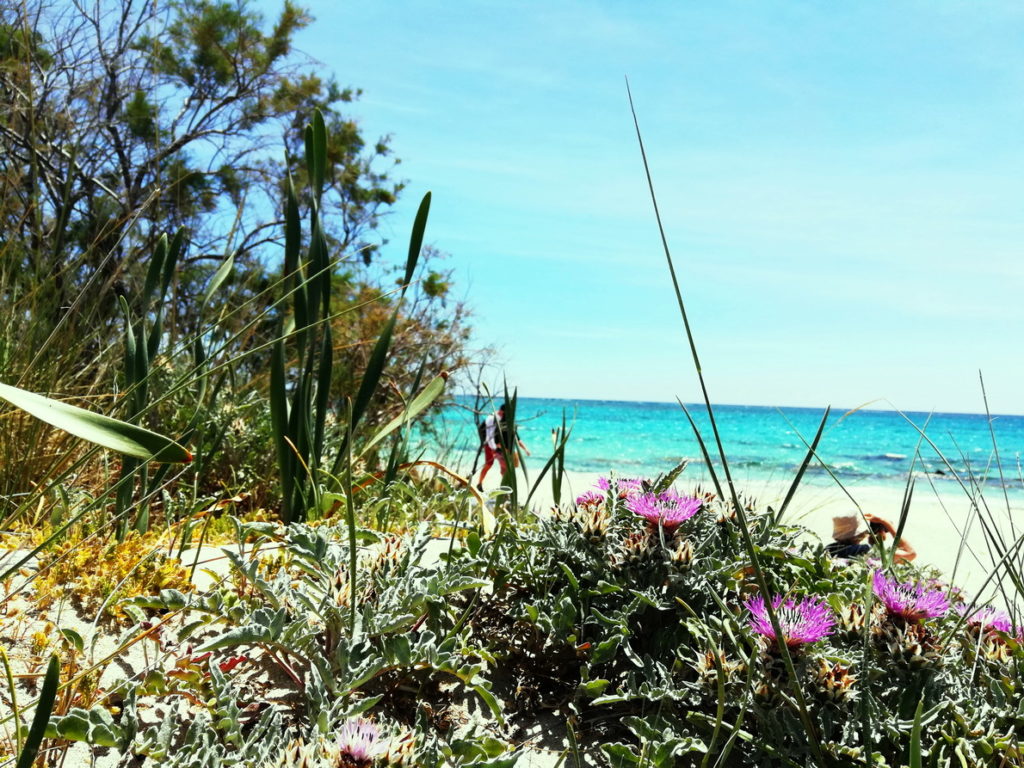
At the very southwestern corner of the island is one of the most famous beaches in the world. Elafonissi is actually an island, a beach, and a lagoon of clear turquoise waters. This is a spectacular nature preserve. Wildflowers cover dunes of bright white sand, and caretta caretta turtles nest here.
You have your choice of routes to get here from Chania. Both follow the national coastal road Kissamos – Chania VOAK/E65/EO90, then turn south to cross through the interior. The shorter route has you turn at Drapanias to the country road Kaloudianon-Chrisoskalitissas (signs for Elafonisi/Paleochora/Topolia). For the longer route, you turn at Tavronitis (just past Maleme) onto the rural route (“EO” or Epar. Od”) Tavronitis-Paleochoras (look for signs for Paleochora).
This slightly longer route takes you by the village of Ano Vouves. It’s famous for its olive tree – one of the oldest in the world, estimated to be between 2,000 and 4,000 years old. The enormous gnarled trunk is a gorgeous sight.
You’ll then pass by Mesavlia, where the Mesavia – Delaian gorge starts. This gorge of 5 km that connects the two villages is a beautiful and not at all challenging hike.
The two route converge again before Elos. This is one of the loveliest villages of the route, where you can see a 14th century Byzantine church an acquaduct from the Ottoman era. The village is shaded with chestnut trees and makes a fine stop for lunch, as there are several simple tavernas.
Just 5 km before you reach Elafnissi you’ll pass the 17th Chryssoskalitsa Monastery. It’s dramatically situated in a rock 25 m above the sea like a fortress, and is an active nunnery.
Route 3- A Short Scenic Drive: Chania to Therisos- 16 km, 30 minutes
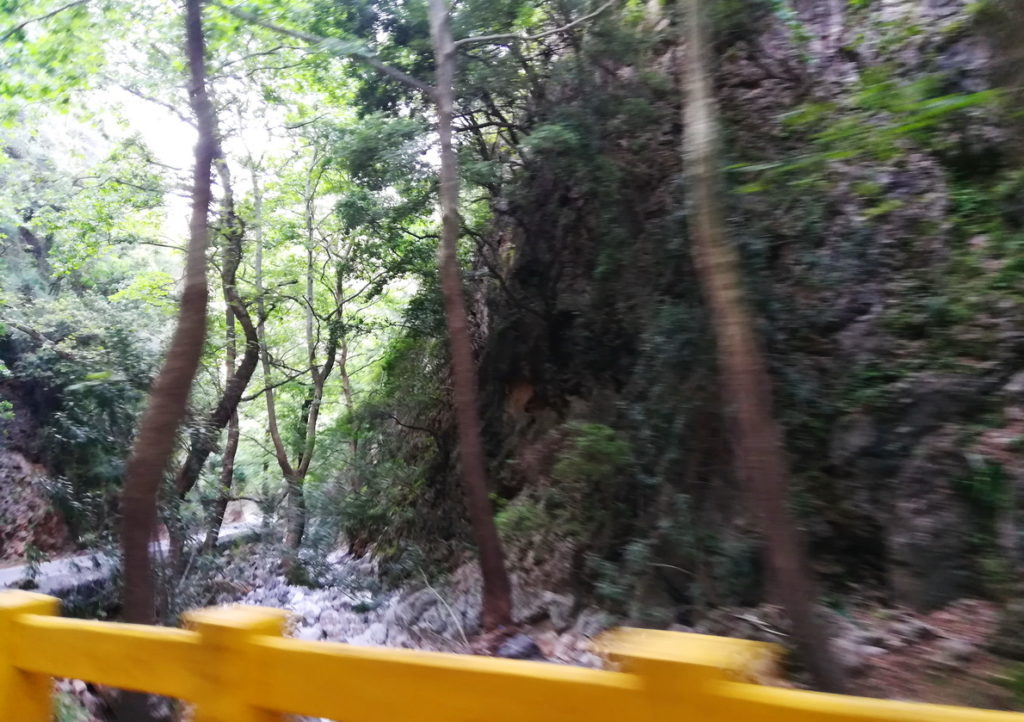
One of the most beautiful half hour drives you’ll ever take is just outside of Chania. Leaving Chania town towards the southwest on Vasiliou Poulaka, you’ll pass through the neighborhood called Perivolia. Follow the signs to Theriso, and you will soon find yourself in a narrow, steep-sided gorge. Trees fill the gorge, and a stream runs alongside the road. The gorge ends in Theriso, a historic village.
In addition to being the birthplace of the other of Eleftherios Venizelos, this was a place of historic uprisings against the Ottomans. I was also the site of the birth of the uprising of Cretans against Prince George of Greece, who opposed Crete’s union with Greece. At Therisos’ Musuem of National Resistance you can learn more.
The other thing that Therisos is famous for is the excellence of the meat. Many tavernas serve top quality grilled or roast goat alongside other Cretan specialties. In warm weather, you’ll die in the shade of trees on large outdoor patios.
It feels so remote and peaceful here. It’s hard to imagine you can be back in the center of Chania in just half an hour.
Driving in Crete, Route 4: Rethymnon to Matala- 75 km, 1.5 hours
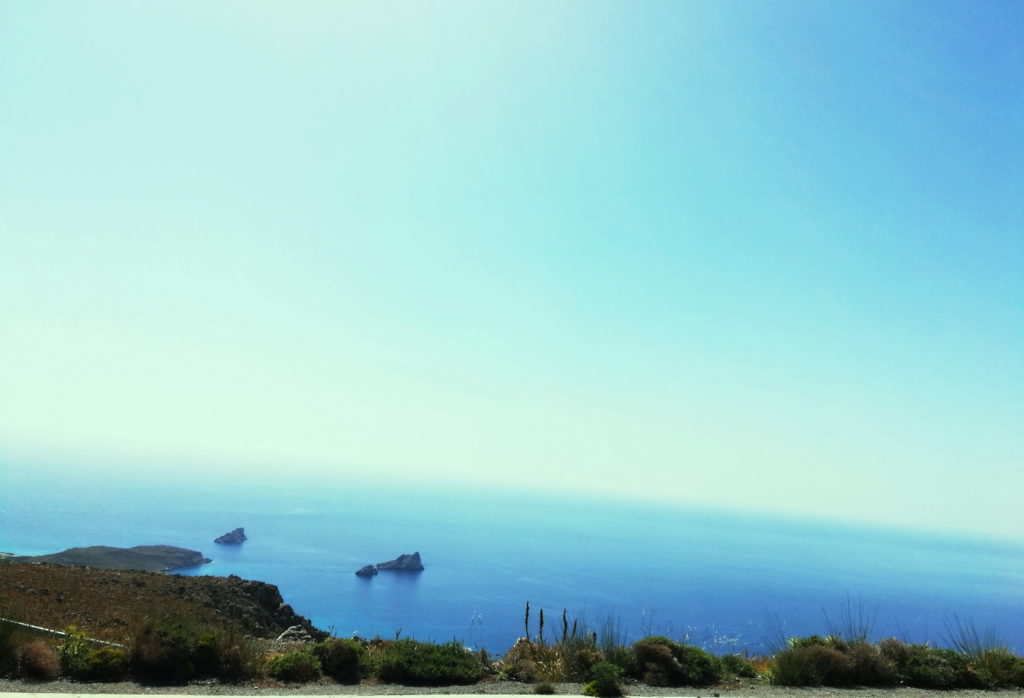
Gorgeous Rethymno with its Venetian monuments and picturesque harbor is the starting point for this trip. The destination is one of Crete’s wildest and most famous beaches- Matala. Matala was largely discovered by the Hippies who camped in the caves on its cliff in the 1970’s (and immortalized in the lyrics of this Joni Mitchell song).
The rural route (“EO” or Epar. Od”) Rethymnou – Agias Galinis is a beauty, taking you through part of the Psiloreitis mountain range. The highlight along the road is the large mountain village (430 m elevation) of Spili. This green village, whose name comes from the word for cave, as there are several nearby.
Whatever the weather, it’s cooler up in shady Spili. What’s more, Spili has the most fabulously refreshing fountain imaginable. Shaded by large plane trees is the “Kefalovrysi.” Here, cold water flows with force through the mouths of 25 carved stone lion heads. The mountain water is absolutely delicious.
About 10 km further along, you’ll reach the small village of Akoumia. If you want to make another stop, you can visit the 14th century Sotirias Christos Church with its fine frescoes, and then enjoy a refreshment in the shady village square.
You’ll reach the south coast at gorgeous Agaia Galini, once a sleepy fishing village, long before that the Minoan harbor of Syvritos, and now a popular resort town, arranged dramatically along the hillside overlooking the pebble beach. Continue from here to the rural route Faistou – Agias (“EO” or “Epar. Od”). After the town of Tymbaki, take the rural route (“EO” or “Epar. Od”) Timpakiou-Kamilariou, and shortly afterward turn onto the rural route (“EO” or “Epar. Od”) Gortinas – Matalon.
This famous beach town has grown since the days of the hippies, but the waters are still crystal clear, and the great white cliff sheltering the beach is dotted with caves.
Route 5 – Sitia to Ierapetra, the Coastal Route- 115 km, 2.5 hours
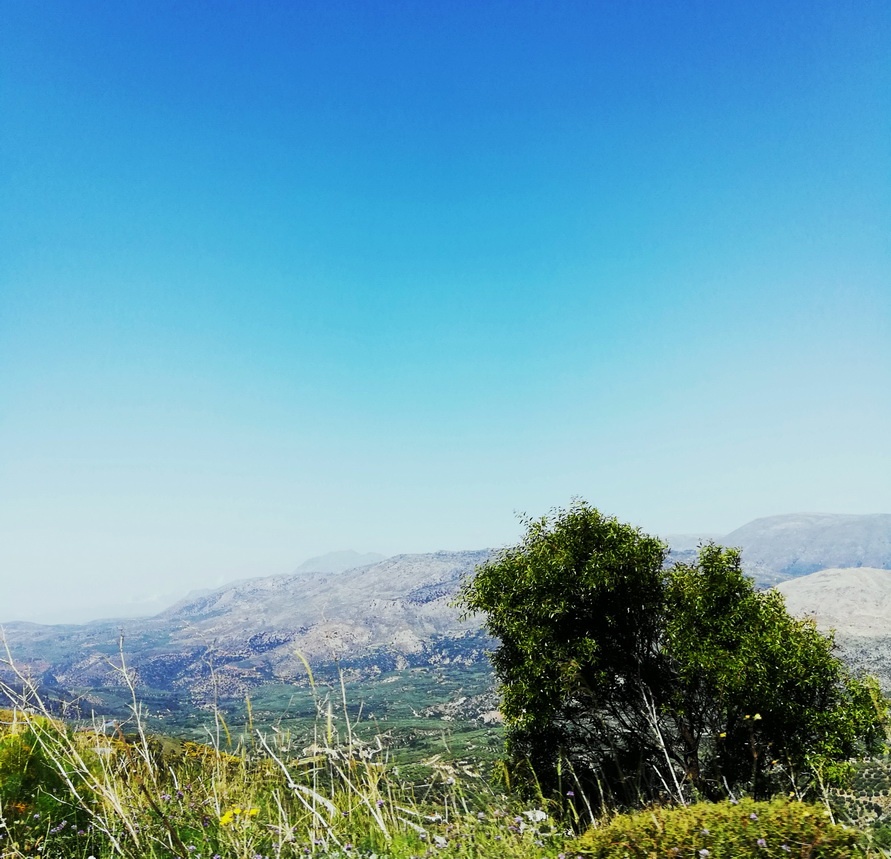
Lasithi – Crete’s eastern edge – is the quieter, wilder side of the island. It’s a fantastic region to explore by car. Starting in the pretty town of Sitia, you’ll set off on the rural route (“EO” or “Epar. Od”) Sitias – Palaikastrou towards the east along the sea, coming soon to the 15th century Toplou monastery, dramatic in its stark landscape. From here, you can take a 12 km detour to Vai, Europe’s largest natural palm forest and a spectacular site. This is also a world-famous beach with pristine waters and silky sands.
Passing through Palaikastro, site of the ancient Minoan port Itanos, you’ll come to Ano Zakros. This simple village is worth a stop for a visit to the Women’s Cooperative, where you can buy fantastic treats made from labor-intensive traditional recipes.
The beaches of Xerokambos are wild and secluded, with pure waters and excellent swimming. A favorite is Argyle, which is the word for clay. The cliff by the beach is made of natural clay – perfect for an impromptu natural spa treatment.
From here, along the rural route (“EO” or “Epar. Od”) Zirou-Palaikastrou, the road rises again dramatically, golden hills giving way to vistas of the Libyan sea in the distance. There are few houses and even fewer cars. You’ll feel as though you have the island entirely to yourself.
Ziros is the largest village, and after passing though here you’ll come to Chandras, a small and tranquil white-washed village of stone houses.
As you descend towards the south coast the Lybian sea comes again into dramatic view, glimpsed through golden fields. The area around Ierapetra is the markt basket of Greece, filled with hothouses providing much of the country’s produce. Ieraptera itself is a pleasing harbor town.
From here, you can take a ferry to Chrissi- a fantastic uninhabited island that is a paradise of silky white sands and Lebanese cedar trees a little over 10 km from Ierapetra. Or if you want to get back to the north coast and explore charming Agios Nikolaos – the smallest of Crete’s four capitals – it’s just 45 minutes to the north, across one of the narrowest sections of the island.
These five drives are as enjoyable as the destinations, a great way to start exploring Greece’s largest island.
Crete is also full of beautiful places to discover on your own by car.

